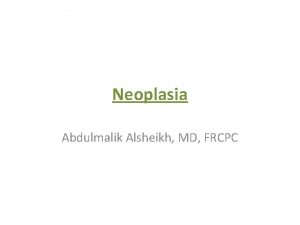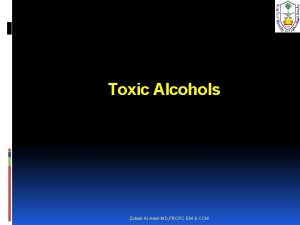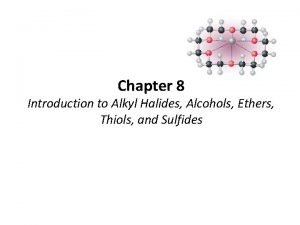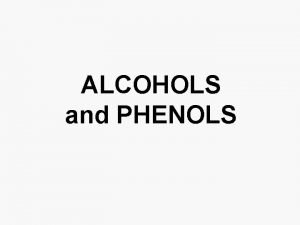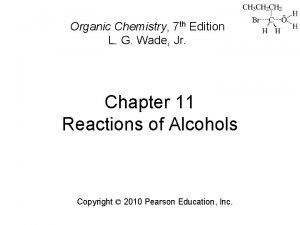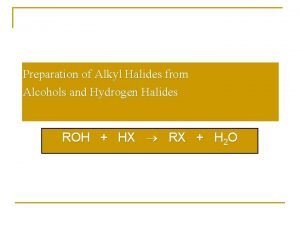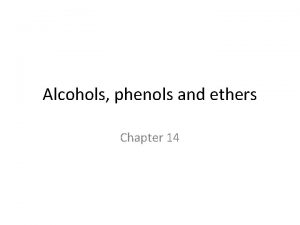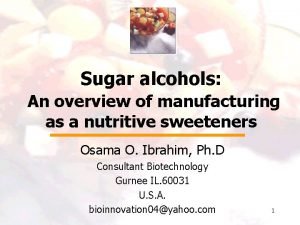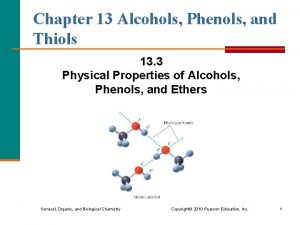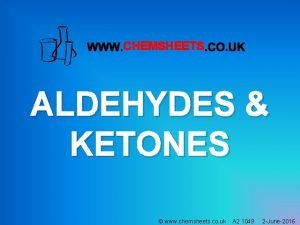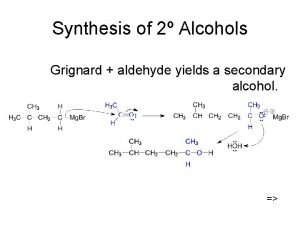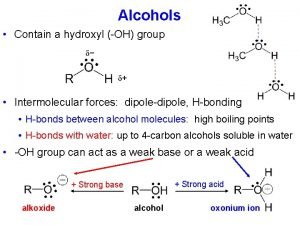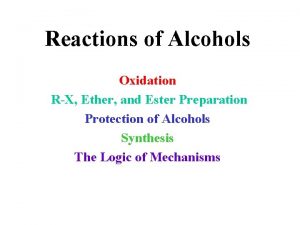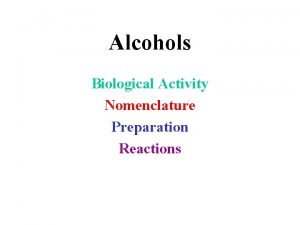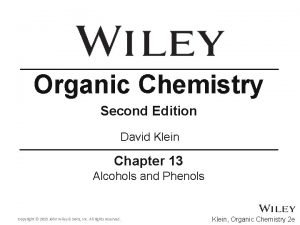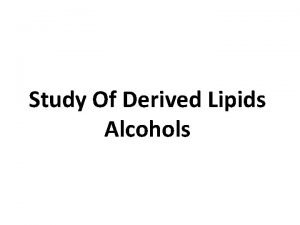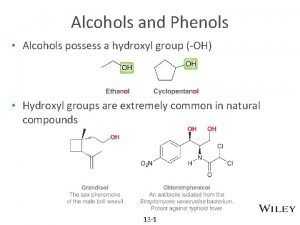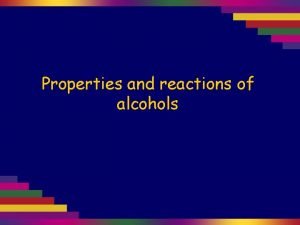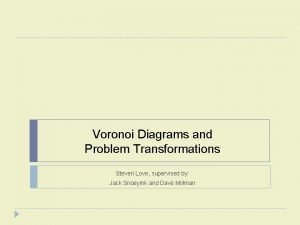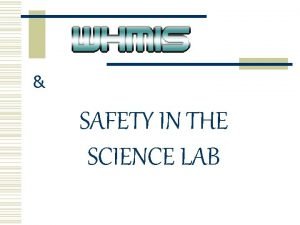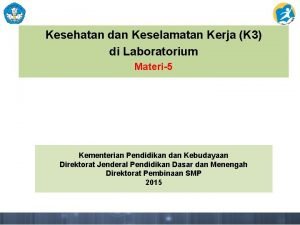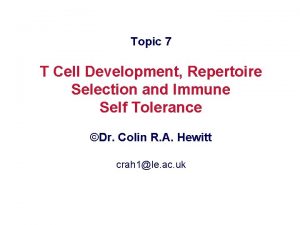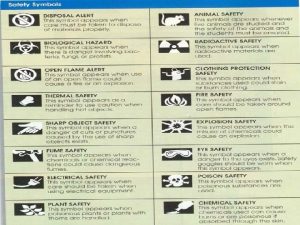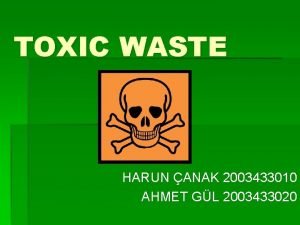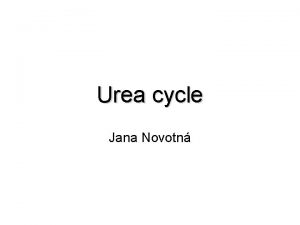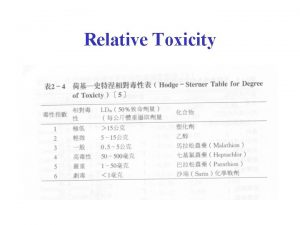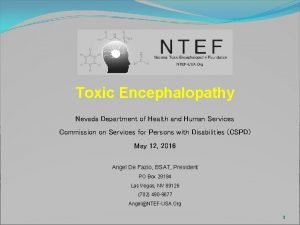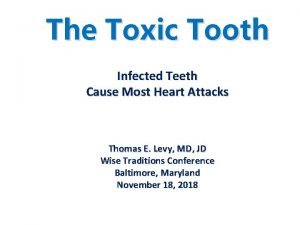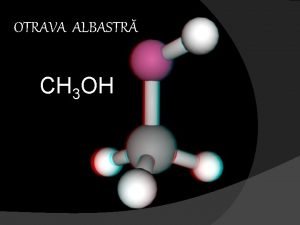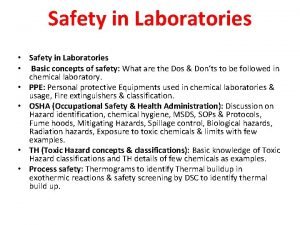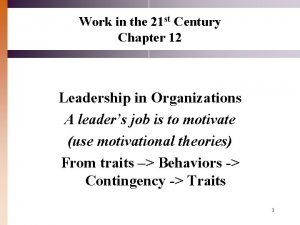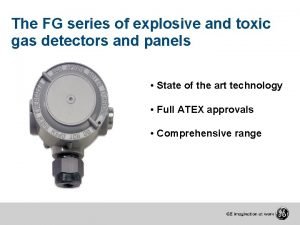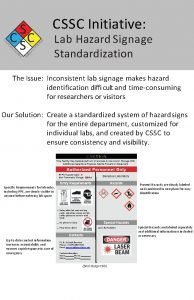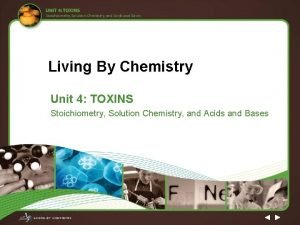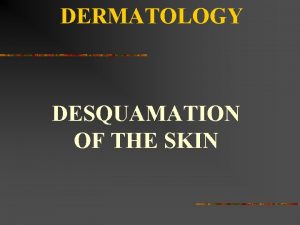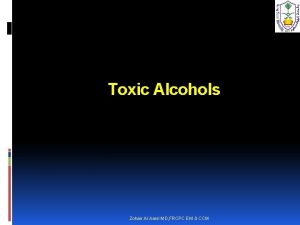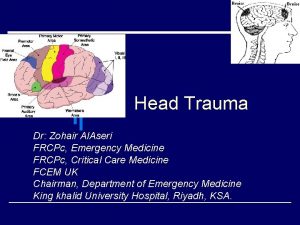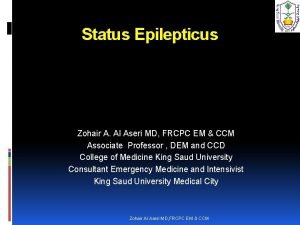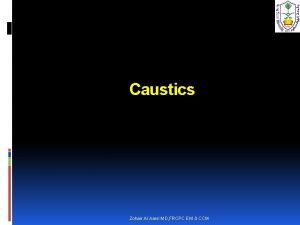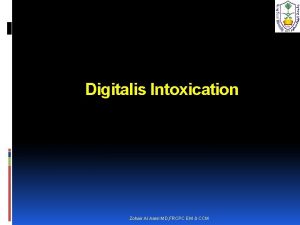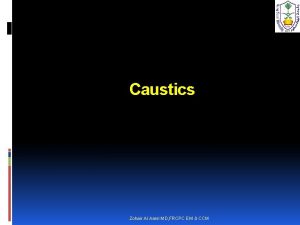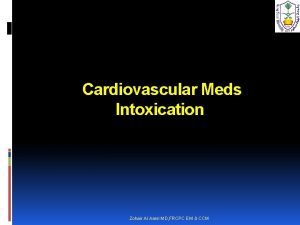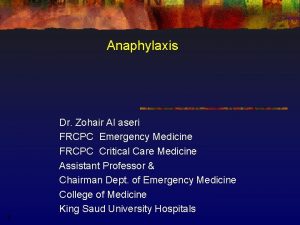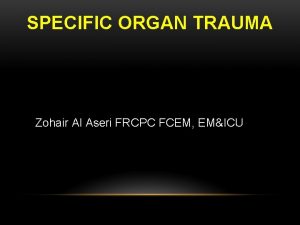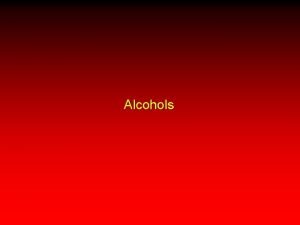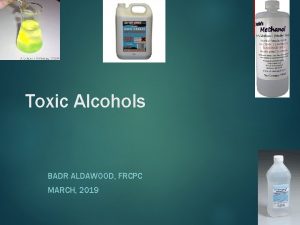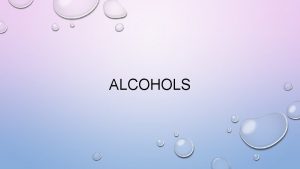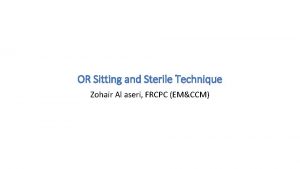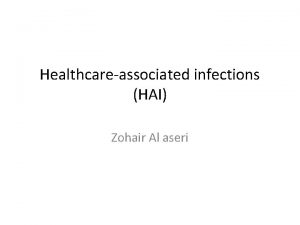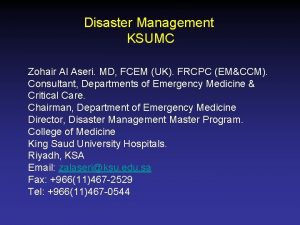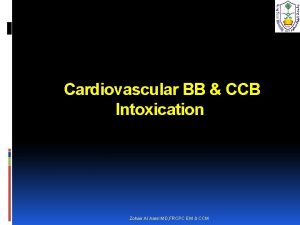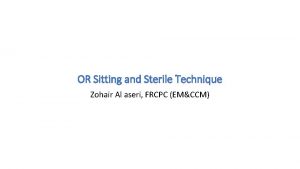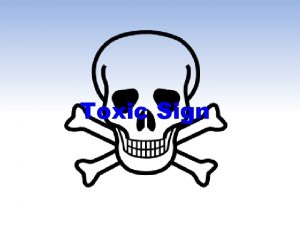Toxic Alcohols Zohair Al Aseri MD FRCPC EM










































































































- Slides: 106

Toxic Alcohols Zohair Al Aseri MD, FRCPC EM & CCM

METHANOL Perspective Methanol is a colorless, volatile, slightly sweettasting alcohol. Certain products found in the home, including antifreeze; wind shield washer fluid; carburetor fluid; duplicator fluid; hobby engine fuel; gasohol; dry gas; Sterno; glass cleaners; and thinners for shellacs, lacquers, adhesives, and inks may contain high concentrations of methanol. Zohair Al Aseri MD, FRCPC EM & CCM

METHANOL Perspective Treatment delay is associated with increased morbidity, making early recognition of clinical and laboratory clues crucial. Zohair Al Aseri MD, FRCPC EM & CCM

Principles of Disease Pharmacology and Metabolism Methanol is absorbed rapidly from the gastrointestinal tract, and blood levels peak 30 to 60 minutes after ingestion. Transdermal and, respiratory tract absorption also has resulted in toxicity, especially in infants. Certain occupations, including painting, glazing, varnishing, lithography, and printing, are at high risk for inhalational exposure to methanol. Inhalational abuse of methanol is a recent trend that can result in toxic serum levels. Zohair Al Aseri MD, FRCPC EM & CCM

Principles of Disease Pharmacology and Metabolism A prolonged half-life of 24 to 30 hours results, which may be extended even further by the concurrent ingestion of ethanol. Small amounts of ingested methanol may be exceptionally toxic. The smallest lethal dose reported is 15 m. L of 40% methanol Zohair Al Aseri MD, FRCPC EM & CCM

Principles of Disease Pharmacology and Metabolism 4 m. L of pure methanol has led to blindness. With appropriate, timely treatment, however, survival without loss of eye sight has been reported despite extremely high levels. From a pediatric perspective, the ingestion of only 1. 5 m. L of 100% methanol in a toddler (0. 15 m. L/kg) is sufficient to produce a toxic blood level of 20 mg/d. L. Zohair Al Aseri MD, FRCPC EM & CCM

Principles of Disease Pharmacology and Metabolism Metabolites of the parent alcohol are extremely toxic Although small amounts of methanol are eliminated via renal and pulmonary routes, 90%is metabolized hepatically. Methanol is oxidized by alcohol dehydrogenase (ADH) to formaldehyde, which is rapidly converted by aldehyde dehydrogenase to formic acid. Zohair Al Aseri MD, FRCPC EM & CCM

Principles of Disease Pharmacology and Metabolism Formic acid is the primary toxicant and accounts for much of the anion gap metabolic acidosis and ocular toxicity peculiar to methanol ingestion. Through a folate-dependent pathway, formic acidis degraded to carbon dioxide and water. Zohair Al Aseri MD, FRCPC EM & CCM

Metabolism of methanol Zohair Al Aseri MD, FRCPC EM & CCM

Pathophysiology Optic neuropathy and putamin necrosis are the two main complications of severe methanol poisoning. Long-term morbidity takes the form of visual impairment, including blindness, and parkinsonian motor dysfunction, characterized by hypokinesis and rigidity. Zohair Al Aseri MD, FRCPC EM & CCM

Pathophysiology Formic acid has a high affinity for iron and, as such, inhibits mitochondrial cytochrome oxidase, halting cellular respiration. Methanol metabolism in the cytosol and mitochondria may account for a second mechanism of adenosine triphosphate depletion. Zohair Al Aseri MD, FRCPC EM & CCM

Pathophysiology Lactate accumulation resulting from hypotension or seizures further compounds the metabolic acidosis predominantly caused by formate. Other mechanisms of toxicity involve increased lipid peroxidation, free radical formation, and impaired protective antioxidant reactions. Severe dysfunction of subcellular metabolism from methanol also has been linked to significant disturbance in proteolytic-antiproteolytic balance. Zohair Al Aseri MD, FRCPC EM & CCM

Pathophysiology The primary sites of ocular injury are the retrolaminar optic nerve and retina. Zohair Al Aseri MD, FRCPC EM & CCM

Pathophysiology Acidosis may accelerate this process, by enhancing nonionic diffusion of formic acid into neurons and further increasing lactate production. This self-perpetuating cycle of acidosis, termed circulus hypoxicus, underscores the need for aggressive correction of p. H to accomplish ion trapping of formate outside the CNS. Zohair Al Aseri MD, FRCPC EM & CCM

Pathophysiology Methanol adversely affects other areas of the CNS, specifically the basal ganglia. Bilateral, symmetrical putaminal hypodensities, hemorrhages, or cystic lesions are characteristic, occurring in 13. 5% of patients. Zohair Al Aseri MD, FRCPC EM & CCM

Pathophysiology Necrosis is described in the subcortical white matter, spinal cord anterior horn cells, and cerebellum. Acute signs and symptoms may be lacking or may take several days to develop, despite the presence of these radiographic findings. Zohair Al Aseri MD, FRCPC EM & CCM

Pathophysiology Reason for localization of neurologic damage to the basal ganglia is unknown. Although some quantitative neuropathologic studies have shown high concentrations of formic acid within the putamen, others show that formate levels are not disproportionately elevated in these areas compared with levels in the blood or other tissues. Zohair Al Aseri MD, FRCPC EM & CCM

Pathophysiology Massive edema adjacent to the putamen shown by MRI suggests a possible localized disruption of the blood-brain barrier. Other proposed mechanisms for the vulnerability of this region include the unique pattern of arterial blood supply and venous drainage and greater metabolic activity. Zohair Al Aseri MD, FRCPC EM & CCM

Clinical Features Diagnosis should be considered in patients with altered mental status, visual complaints, or metabolic acidosis or in patients with occupations that put them at high risk for exposure. Because methanol is a poor substrate for ADH, a latency period exists between the time of ingestion and onset of visual or metabolic disturbance. Zohair Al Aseri MD, FRCPC EM & CCM

Clinical Features The typical 12 - to 24 -hour latency may be shorter when large amounts are consumed or longer when ethanol is co-ingested (range 40 min to 72 hr). In patients who present early, formic acid accumulation may be ongoing, with risk for significant toxicity despite being asymptomatic. When symptoms manifest, they are primarily neurologic, gastrointestinal, or ocular in nature. Zohair Al Aseri MD, FRCPC EM & CCM

Clinical Features Early Symptoms: Depressed mental status Confusion Ataxia Nonspecific complaints Weakness Dizziness Anorexia Headache Nausea In severe cases, coma and seizures. Vomiting and abdominal pain common but their absence does not rule out a serious ingestion. Zohair Al Aseri MD, FRCPC EM & CCM

Clinical Features Abdominal tenderness may result from pancreatitis, and elevation of serum amylase is relatively common. It has been noted increased salivary amylase isoenzyme without pancreatic inflammation. Zohair Al Aseri MD, FRCPC EM & CCM

Clinical Features Visual disturbances in 50% of patients cloudy, blurred, indistinct, or misty vision or may note yellow spots or, rarely, photophobia. The most common acute field defect is a dense central scotoma. Some patients compare their visual symptoms with “stepping out into a snowstorm, ” a complaint unique to methanol ingestion. Patients can have a complete lack of light perception and total loss of vision. Zohair Al Aseri MD, FRCPC EM & CCM

Clinical Features Optic disk hyperemia is seen at 18 to 48 hours after ingestion. Peripapillary retinal edema follows, is most striking in the nerve fiber layer along the vascular arcades, and only rarely involves the macula. Sluggishly reactive or fixed and dilated pupils indicate a poor prognosis. Pallor and cupping, indicative of optic atrophy, are late findings suggesting a poor prognosis for visual recovery. Occasionally, the fundus may appear normal, even in patients with visual symptoms. Zohair Al Aseri MD, FRCPC EM & CCM

Clinical Features Compensatory tachypnea Serum bicarbonate concentrations of less than 5 m. Eq/L and an arterial p. H less than 7. 0. Early tachycardia has been noted, but in general, cardiovascular abnormalities are rare. Hypotension and bradycardia, when present, are preterminal findings. Zohair Al Aseri MD, FRCPC EM & CCM

Clinical Features Prognosis correlate with the degree of acidosis time to presentation initiation of treatment within 8 hours of exposure. coma, seizures p. H less than 7. 0. Zohair Al Aseri MD, FRCPC EM & CCM

Clinical Features Patients surviving the acute phase of toxicity may be left with permanent blindness or neurologic deficits, such as parkinsonism, toxic encephalopathy, polyneuropathy, cognitive dysfunction, transverse myelitis, primitive reflexes, or seizures. Zohair Al Aseri MD, FRCPC EM & CCM

Diagnostic Strategies A severe anion gap metabolic acidosis Because the onset of acidosis may be delayed 12 to 24 hours, the presence of a normal anion gap does not rule out methanol exposure. anion gap is due primarily to the presence of formic acid, with a variable contribution from lactic acid Absence of high anion gap acidosis has been described in cases with Ethanol Lithium Bromide ingestion Zohair Al Aseri MD, FRCPC EM & CCM

Diagnostic Strategies High osmol gap. Zohair Al Aseri MD, FRCPC EM & CCM

Diagnostic Strategies The “normal” osmol gap is less than 10 m. Osm/kg when the preceding equation is used. There is considerable variability in baseline osmolal gaps in patients, particularly children. An osmol gap significantly greater than 10 m. Osm/kg may be a useful aid in the diagnosis of toxic alcohol ingestion. Zohair Al Aseri MD, FRCPC EM & CCM

Diagnostic Strategies Caution should be taken in ruling out toxic alcohol ingestion with a “normal” osmol gap for several reasons. First, calculated serum osmolality results may vary among laboratories and must be done by the freezing point depression method. Delayed presentation after toxic alcohol ingestion may be associated with prior metabolism of most of the parent alcohol. Finally, a toxic level of either methanol or ethylene glycol may be present with a gap of only 10 m. Osm/kg. Zohair Al Aseri MD, FRCPC EM & CCM

Diagnostic Strategies serum toxic alcohol level is necessary if not readily available, empirical treatment is warranted. Rhabdomyolysis, pancreatitis, and metabolic derangements, such as hypomagnesemia, hypokalemia, and hypophosphatemia, are also described with methanol poisoning. Zohair Al Aseri MD, FRCPC EM & CCM

Diagnostic Strategies CT may be indicated in an intoxicated patient with altered mental status. The characteristic finding of bilateral putaminal lesions suggests methanol poisoning , hypoxicischemic insult, encephalitis, and certain metabolic disorders. Ischemic necrosis, cerebral edema, or brain hemorrhages also may be noted. Zohair Al Aseri MD, FRCPC EM & CCM

Diagnostic Strategies Follow-up scans may have prognostic value because parkinsonian features are unlikely to develop in patients whose putaminal lesions resolve within a short time frame. MRI may also detect putaminal aberrations or optic neuropathy from methanol intoxication. Zohair Al Aseri MD, FRCPC EM & CCM

Differential Considerations Ethylene glycol and methanol may cause a “double gap” (i. e. , an osmol gap in addition to the anion gap). Zohair Al Aseri MD, FRCPC EM & CCM

Differential Considerations elevated osmol gap include isopropyl alcohol, ethanol, propylene glycol, mannitol, glycerol, and ethyl ether. double-gap acidosis may be encountered include diabetic ketoacidosis; alcoholic ketoacidosis; acetonitrile, methanol, ethylene glycol, and propylene glycol toxicity; multiple organ failure; chronic renal failure; and critical illness. Hyperlipidemia and hyperproteinemia, by decreasing the measured sodium concentration, can increase the osmolal gap. Zohair Al Aseri MD, FRCPC EM & CCM

Differential Considerations Characteristically, isopropanol does not cause an increased anion gap. Certain unusual characteristics of methanol and ethylene glycol intoxication lead to the specific diagnosis: The presence of ocular complaints unique to methanol poisoning is a valuable clue. Ethylene glycol ingestion often is associated with calcium oxalate crystalluria, which is not seen in methanol ingestion. Zohair Al Aseri MD, FRCPC EM & CCM

Differential Considerations Ultimately, the definitive diagnosis depends on the identification of the parent alcohol in the blood by laboratory tests that may not be routinely available. It is often necessary to start treatment based on clinical suggestion alone. Because the initial treatment for methanol and ethylene glycol is almost identical, identification of the specific toxic alcohol is not crucial to the initiation of therapy. Zohair Al Aseri MD, FRCPC EM & CCM

ETHYLENE GLYCOL Perspective Ethylene glycol is a viscous, colorless, odorless, slightly sweet-tasting liquid. Because it lowers the freezing point of water, its primary utility is as a commercial antifreeze or coolant. airplane deicing solutions, hydraulic brake fluids, and industrial solvents/precursors; it is in certain paints, lacquers, and cosmetics. Zohair Al Aseri MD, FRCPC EM & CCM

ETHYLENE GLYCOL Perspective Most ethylene glycol poisonings occur with antifreeze. Zohair Al Aseri MD, FRCPC EM & CCM

ETHYLENE GLYCOL Perspective If treated early and aggressively, ethylene glycol poisoning is unlikely to result in death. Failure to recognize and treat ethylene glycol ingestion may result in multi organ failure and death within 24 to 36 hours. Zohair Al Aseri MD, FRCPC EM & CCM

Principles of Disease Pharmacology and Metabolism Absorption of ethylene glycol is rapid afteringestion. Peak blood levels are reached within 1 to 4 hours after ingestion. In contrast to methanol and isopropanol, ethylene glycol is nonvolatile at room temperature so absorption via inhalation is unlikely. Reported half-lives range from 3 to 8. 6 hours. Zohair Al Aseri MD, FRCPC EM & CCM

Principles of Disease Pharmacology and Metabolism The toxic and lethal doses of 100% ethylene glycol have been reported as 0. 2 m. L/kg and 1. 4 m. L/kg. Twenty-seven percent of ethylene glycol is excreted unchanged by the kidneys. The remainder is hepatically oxidized via ADH and other oxidative enzymes to various toxic organic aldehydes and acids Zohair Al Aseri MD, FRCPC EM & CCM

Metabolism of ethylene glycol. GAO, glycolic acid oxidase; LDH, lactate dehydrogenase; NAD, nicotinamide adenine dinucleotide; NADH, reducedform of nicotinamide adenine dinucleotide Zohair Al Aseri MD, FRCPC EM & CCM

Pathophysiology 2. 3%of a dose of ethylene glycol ultimately is converted to oxalic acid, most of which is excreted in the urine. A fraction of oxalic acid combines with calcium to form calcium oxalate crystals, which precipitate in renal tubules, brain, and other tissues. Zohair Al Aseri MD, FRCPC EM & CCM

Pathophysiology human proximal tubular cells showed that toxicity occurred primarily from the direct effect of oxalic acid, despite exposure to much higher levels of glycolate. Zohair Al Aseri MD, FRCPC EM & CCM

Pathophysiology An intermediary of glycolic acid metabolism, glyoxylic acid, theoretically can be shunted toward pyridoxine-dependent or thiamine-dependent pathways, which generate the nontoxic products glycine and α-hydroxy-β-ketoadipate. Based on this biochemical observation, both of these cofactors are routinely used in therapy. Zohair Al Aseri MD, FRCPC EM & CCM

Pathophysiology The metabolism of ethylene glycol results in a profound anion gap metabolic acidosis caused mainly by glycolic acid. Zohair Al Aseri MD, FRCPC EM & CCM

Clinical Features The clinical syndrome with ethylene glycol ingestionis divided into four stages: acute neurologic stage cardiopulmonary stage renal stage delayed neurologic sequelae stage Patients may die in any stage Zohair Al Aseri MD, FRCPC EM & CCM

Clinical Features Poor prognostic factors include Hyperkalemia severe acidosis Seizures coma Metabolic acidosis and symptoms typically occur within 4 to 8 hours, but may be delayed for 12 hours or longer if ethanol has been co-ingested. Zohair Al Aseri MD, FRCPC EM & CCM

Clinical Features Stage I, the acute neurologic stage, occurs 30 minutes to 12 hours after ingestion. slurred speech, nystagmus, ataxia, and vomiting. With large ingestions, more dramatic neurologic findings, such as Hallucinations Convulsions coma Zohair Al Aseri MD, FRCPC EM & CCM

Clinical Features Stage II, the cardiopulmonary stage, occurs 12 to 24 hours after ingestion. mild hypertension and tachycardia. Tachypnea due to metabolic acidosis or may herald the onset of cardiogenic or noncardiogenic pulmonary edema. (ARDS) cause is unknown Zohair Al Aseri MD, FRCPC EM & CCM

Clinical Features Circulatory collapse may occur as a result of myocardial depression. Hypocalcemia, rarely associated with tetany or cardiac dysrhythmia occurs in 30%of patients as a result of systemic chelation of calcium by oxalate. Myositis with muscle tenderness and creatine kinase (CK) elevation results from skeletal muscle inflammation and necrosis. Zohair Al Aseri MD, FRCPC EM & CCM

Clinical Features Stage III, the renal stage, occurs 24 to 72 hours after ingestion. flank pain if awake costophrenic angle tenderness. Calcium oxalate monohydrate or dihydrate crystalluriais seen in only 50%of cases. Hematuria and proteinuria are common oliguriais not always present but may develop 12 hours after ingestion and may progress to frank anuria. Zohair Al Aseri MD, FRCPC EM & CCM

Clinical Features Stage IV, the delayed neurologic sequelae stage, occurs 6 to 12 days after ingestion manifests as cranial neuropathy. All cases have been associated with renal failure. dysarthria, dysphagia, tongue deviation, visual deterioration, and internal ophthalmoplegia. Delayed and persistent cognitive and motor deficits, such as ataxia, chorea, coma, and late personality changes Zohair Al Aseri MD, FRCPC EM & CCM

Clinical Features Total paralysis in reported cases most patients are left with residual neurologic deficits. Zohair Al Aseri MD, FRCPC EM & CCM

Diagnostic Strategies serum electrolytes, calcium, BUN, creatinine, serum glucose, serum osmolality, blood ethanol level, ABG, ethylene glycol level Electrocardiogram urinalysis. crystalluria is considered the hallmark of ethylene glycol ingestion, its absence does not rule out the diagnosis because less than half of patients have this finding. Zohair Al Aseri MD, FRCPC EM & CCM

Diagnostic Strategies Crystalluria Different shapes envelope-shaped calcium oxalate needle-shaped calcium oxalate Other crystal shapes been noted so that in the setting of combined anion and osmolal gap elevation, the presence of any type of crystalluria warrants a search for ethylene glycol. Zohair Al Aseri MD, FRCPC EM & CCM

Diagnostic Strategies Healthy individuals with dietary excessesof vitamin C or foods rich in oxalate, such as tomatoes, garlic, spinach, rhubarb, cocoa, and tea, may exhibit calcium oxalate crystalluria. Zohair Al Aseri MD, FRCPC EM & CCM

Diagnostic Strategies Irrigating the urinary bladder with 50 to 100 m. Lof saline, centrifuging the irrigant, and examining the sediment for crystals may yield the diagnosis in patients who are already anuric. Other findings decreased specific gravity Proteinuria microscopic hematuria pyuria Zohair Al Aseri MD, FRCPC EM & CCM

Diagnostic Strategies Freshly voided urine can be examined for fluorescence with a Wood's lamp. Sodium fluoresceinis added to antifreeze to aid in the detection of radiator leaks. Urinary fluorescence may be seen 6 hours after ingestion of fluorescein-containing antifreeze. The lack of fluorescence does not rule out ethylene glycol ingestion Zohair Al Aseri MD, FRCPC EM & CCM

Diagnostic Strategies Leukocytosis One third of patients have hypocalcemia, QT prolongation on the electrocardiogram leads to the early diagnosis of hypocalcemia. Rarely, profound hypocalcemia resulting in seizures and tetany may occur. The CK can be elevated owing to toxic effects of ethylene glycol metabolites on muscle tissue Zohair Al Aseri MD, FRCPC EM & CCM

Diagnostic Strategies profound anion gap metabolic acidosis when the metabolites glycolic acid and glyoxylic acid (and, to some extent, lactic acid) accumulate. elevated osmolal gap as measured by freezing point depression is a clue to the diagnosis of ethylene glycol toxicity. Zohair Al Aseri MD, FRCPC EM & CCM

Diagnostic Strategies CT cerebral edema MRI in one patient with delayed cranial neuropathy showed gadolinium enhancementof cranial nerve V bilaterally, possibly secondary to calcium oxalate deposition. Electroencephalographic findings have been nonspecific. Zohair Al Aseri MD, FRCPC EM & CCM

Management Methanol and ethylene glycol ingestions are treated essentially the same As in any overdose setting, resuscitation and stabilization are paramount. Specific blood levels that confirm the presence of these substances may not be readily available, and a delay in instituting therapy can lead to irreversible organ damage or death. For any significant history of exposure, treatment should be initiated pending a confirmatory toxic alcohol blood level. Zohair Al Aseri MD, FRCPC EM & CCM

Management gastric emptying has not been shown to alter clinical course or outcome and may be associated with complications Activated charcoalis not useful. Zohair Al Aseri MD, FRCPC EM & CCM

Management Obtunded patients should receive intravenous (IV) naloxone, dextrose (or have a bedside glucose determination), and thiamine, if clinically indicated. Forced diuresis is of no value Early intubation may be indicated to protect the airway against aspiration and in anticipation of further deterioration in mental status. Zohair Al Aseri MD, FRCPC EM & CCM

Management Absence of symptoms shortly after ingestion does not exclude a potentially toxic dose should not be used as a triage criterion Zohair Al Aseri MD, FRCPC EM & CCM

Management Clinically significant mucous membrane irritation should be referred for evaluation. Decontamination of dermal exposures include routine cleansing with mild soap and water. Removal of contact lenses and immediate irrigation with room temperature tap water is recommended for ocular exposures. If eye injury are present, ophthalmologic consultation or follow-up may be helpful. Zohair Al Aseri MD, FRCPC EM & CCM

Management 3 ttt goals for methanol or ethylene glycol toxicity: (1) correction of metabolic acidosis with bicarbonate (2) ADH enzyme blockade, which inhibits the metabolism of methanol and ethylene glycol to toxic metabolites (3) removal of the parent alcohol and its metabolites by hemodialysis. Zohair Al Aseri MD, FRCPC EM & CCM

Management Early correction of metabolic acidosis may be beneficial in reversing methanol-induced visual impairment, most likely related to the induction of a larger fraction of dissociated formic acid, which should decrease the amount of formic acid entering the CNS. Zohair Al Aseri MD, FRCPC EM & CCM

Management Depending on the severity of the patient's acidosis, IV bicarbonate can be administered by intermittent boluses, an initial bolus followed by an infusion, or infusion alone. Boluses of 1 to 2 m. Eq/kg to attain a target serum p. Hof 7. 45 to 7. 50 followed by an infusion of 150 m. Eq/L of sodium bicarbonate in 5% dextrose at 1. 5 to 2 times the maintenance fluid rate are suggested. Zohair Al Aseri MD, FRCPC EM & CCM

Management Metabolism of the parent compounds by the enzyme ADH must be blocked by either ethanol or fomepizole (Antizol). Started in any adult or child with symptoms or with methanol or ethylene glycol levels greater than 20 mg/d. L, even if asymptomatic. If ethanol is used to block ADH, the goal is to maintain the blood ethanol level between 100 and 150 mg/d. L Zohair Al Aseri MD, FRCPC EM & CCM

Management When dosing ethanol, it is also important to measure the patient's initial blood ethanol level. If it is greater than 100 mg/d. L, a loading dose is unnecessary, and the patient can be started on a maintenance The required maintenance dose of ethanol may nearly triple during hemodialysis because ethanol also is efficiently removed. Zohair Al Aseri MD, FRCPC EM & CCM

Management Ethanol may be given orally or intravenously. Potential side effects of IV administration include CNS depression Respiratory depression Hypotension Vomiting Hypoglycemia Thrombophlebitis Oral ethanol loading may be associated with gastritis. Zohair Al Aseri MD, FRCPC EM & CCM

Management Initial close monitoring of serum ethanol and glucose levels every 1 to 2 hours is essential until a steady-state level of 100 to 150 mg/d. L is achieved. Levels should be checked every 2 to 4 hours thereafter. Zohair Al Aseri MD, FRCPC EM & CCM

Standard Range of Therapeutic Doses of Ethanol Based on Average Pharmacokinetic Values Zohair Al Aseri MD, FRCPC EM & CCM

Management Fomepizole blocks the metabolism of methanol and ethylene glycol by ADH and prevents the formation of toxic metabolites. When methanol or ethylene glycol metabolism is blocked by fomepizole, their half-lives increase to an average of 52 and 17 hours, respectively. Fomepizoleis a pregnancy category C drug although not approved for use in children, its use has been reported Zohair Al Aseri MD, FRCPC EM & CCM

Management Fomepizole Potential advantages Ease of administration predictable pharmacokinetics improved patient safety profile a standardized and less complicated dosing regimen that does not require direct observation or frequent blood monitoring longer duration of action Lack of CNS depression. Zohair Al Aseri MD, FRCPC EM & CCM

Management Fomepizole 15 mg/kg followed by 10 mg/kg every 12 hours for four doses. After five doses, the dose increases to 15 mg/kg every 12 hours until the ethylene glycol concentration is undetectable or less than 20 mg/d. L and the patient is asymptomatic with a normal arterial p. H. Dosing changes are required during hemodialysis. Zohair Al Aseri MD, FRCPC EM & CCM

Management Fomepizole Side effects: Headache Nausea Dizziness inflammation at the site of infusion, rash, eosinophilia mild, reversible transaminase elevation. Zohair Al Aseri MD, FRCPC EM & CCM

Management Hemodialysis decreases the half-life of methanol and ethylene glycol to 2. 5 to 3. 5 hours. Peritoneal dialysis and hemoperfusion are much less effective. Zohair Al Aseri MD, FRCPC EM & CCM

Management Hemodialysis Indications metabolic acidosis renal compromise visual symptoms (methanol) deterioration despite intensive supportive care electrolyte imbalances unresponsive to conventional therapy. Zohair Al Aseri MD, FRCPC EM & CCM

Management Hemodialysis The endpoint is an undetectable serum ethylene glycol or methanol concentration and the disappearance of acid-base abnormalities and signs of systemic toxicity. Closure of the anion gap also may serve as an endpoint for hemodialysis in situations in which levels are not available or reliable (i. e. , in patients with delayed presentation). Zohair Al Aseri MD, FRCPC EM & CCM

Management In methanol poisoning, the rate of the final degradation reaction of formic acid to carbon dioxide and water depends on the cofactor folate Studies in animals and limited human data suggest that formate metabolism is enhanced with the use of folate. 50 mg of leucovorin (folinic acid) should be given IV every 4 hours to adults with methanol toxicity. Zohair Al Aseri MD, FRCPC EM & CCM

Management In ethylene glycol cofactors thiamine and pyridoxine empirical administration is reasonable thiamine 100 mg IV every 6 hours, and pyridoxine, 50 mg every 6 hours for 2 days Zohair Al Aseri MD, FRCPC EM & CCM

Management IV calcium With symptomatic hypocalcemia, should be supplemented, albeit cautiously, to avoid further precipitation of calcium oxalate crystalsin tissues. Asymptomatic hypercalcemia need not be treated. Magnesium is a cofactor along with thiamine for the detoxification of glycolicacid and should be replaced in patients who are deficient. Zohair Al Aseri MD, FRCPC EM & CCM

Disposition If hemodiyalsis is not available, the patient should be given an ADH inhibitor and transferred to a setting where dialysis is available. Zohair Al Aseri MD, FRCPC EM & CCM

ISOPROPYL ALCOHOL Perspective Isopropyl alcohol (isopropanol) is a clear, colorless liquid with a slightly bitter taste. It isthe second most commonly ingested alcohol after ethanol. Zohair Al Aseri MD, FRCPC EM & CCM

ISOPROPYL ALCOHOL Perspective Rubbing alcohols, which contain 70 to 91% isopropanol or ethanol, are frequent sources skin and hair products, nail polish removers, disinfectants, window and pine household cleaners, and antifreeze. Zohair Al Aseri MD, FRCPC EM & CCM

ISOPROPYL ALCOHOL Perspective Isopropanol and its major metabolite acetone cause CNS depression Typical fatality involves a chronic, older alcoholic with mixed ethanol-isopropanol intoxication after a drinking binge Zohair Al Aseri MD, FRCPC EM & CCM

ISOPROPYL ALCOHOL Perspective Absorption of isopropanol is rapid and complete; 80%of a dose is absorbed within 30 minutes of ingestion. The kidneys excrete 20% as unchanged isopropanol. A small portion is resecreted into the stomach and saliva the remaining 80% is metabolized in the liver to acetone by ADH. Acetone is excreted primarily by kidneys, with small amounts expired through the lungs. Zohair Al Aseri MD, FRCPC EM & CCM

Metabolism of isopropanol Zohair Al Aseri MD, FRCPC EM & CCM

ISOPROPYL ALCOHOL Perspective blood levels peak 30 minutes to 3 hs after elimination with a half-life of 3 to 7 hours. In children, the half-life may be slightly shorter. Acetone is eliminated more slowly, with a half-life of 22 hours. A potentially lethal dose in adults is 150 to 240 m. L (2– 4 m. L/kg) Zohair Al Aseri MD, FRCPC EM & CCM

Pathophysiology Isopropanol is a potent CNS depressant, but the mechanism of action is unclear. Acetone is also a CNS depressant In large doses, isopropanol causes hypotension from peripheral vasodilation and direct myocardial depression. Zohair Al Aseri MD, FRCPC EM & CCM

Pathophysiology Topical effects include corneal epithelialization or dermal burns de- Acetone does not seem to be shunted into the formation of acetoacetate or β-hydroxybutyrate; The finding of ketosis without acidosis is characteristic of isopropyl ingestion. Zohair Al Aseri MD, FRCPC EM & CCM

Clinical Findings GI and CNS predominate. Odor of acetone rather than ethanol detected on Headache or dizziness and may exhibit neuromuscular incoordination, confusion, and nystagmus. Severe ingestions may result in deep coma, which is prolonged compared with ethanol. Zohair Al Aseri MD, FRCPC EM & CCM

Clinical Findings Loss of deep tendon, corneal, or protective airway reflexes Extensor response to plantar reflex testing. Pupillary size varies, miosis is most common. Abdominal pain, nausea, and vomiting. Gastritis can occur with dermal and oral exposure. Zohair Al Aseri MD, FRCPC EM & CCM

Clinical Findings Hypotension with a mortality rate of 45%. Sinus tachycardia is common Atrial and ventricular dysrhythmias are rare Hypothermia is frequent. Rarely, myoglobinuria, acute tubular necrosis, hepatic dysfunction, and hemolytic anemia have been reported. Zohair Al Aseri MD, FRCPC EM & CCM

Clinical Findings Metabolic acidosis is not present Hyperglycemia may be noted Zohair Al Aseri MD, FRCPC EM & CCM

Diagnostic Strategies isopropanol level peaks occur soon after ingestion serum electrolytes, BUN, creatinine Osmolality serum and urine ketones ABG acetone levels peak 4 hours after ingestion. The most common laboratory abnormality is ketosis with little or no acidosis and normal blood glucose levels. Zohair Al Aseri MD, FRCPC EM & CCM

Diagnostic Strategies Most common laboratory abnormality is ketosis with little or no acidosis and normal blood glucose levels. ketosis is from the metabolite acetone, which can be detected in the blood 15 minutes after ingestion and in the urine 3 hours after ingestion. Isopropanol and acetone contribute to the increased osmol gap. 1 -mg/d. L increase in blood isopropyl alcohol concentration should result in a 0. 17 -m. Osm/kg increase in serum osmolality. Zohair Al Aseri MD, FRCPC EM & CCM

Diagnostic Strategies falsely elevate creatinine without high urea Creatinine is expected to increase 1 mg/d. L for every 100 mg/d. L of acetone. A CK level should be checked because patients with isopropanol toxicity may have coma-induced myoglobinuria and rhabdomyolysis. Zohair Al Aseri MD, FRCPC EM & CCM

Differential Considerations Patients who ingest significant amounts of isopropanol appear intoxicated or have depressed consciousness, and the differential diagnosis includes all of the causes of altered mental status in an alcoholic patient, as discussed previously. The presence of ketosis warrants a search for diabetic ketoacidosis, alcoholic ketoacidosis, salicylism, cyanide, or starvation ketosis. Zohair Al Aseri MD, FRCPC EM & CCM

Management and Disposition Neither gastric emptying Hypotension should be managed with fluids and vasopressors as needed. If the patient remains hypotensive or has further vital sign deterioration despite these measures, dialysis is indicated. Some authors also recommend dialysis for isopropanol serum levels greater than 400 mg/d. L Zohair Al Aseri MD, FRCPC EM & CCM

Zohair Al Aseri MD, FRCPC EM & CCM
 Carcinoma in situ
Carcinoma in situ Polyp
Polyp Zohair serum
Zohair serum Zohair hair serum
Zohair hair serum Alcohols nomenclature
Alcohols nomenclature Sp
Sp High boiling point alcohols
High boiling point alcohols Lucas test reaction
Lucas test reaction Preparation of alkyl halides from alcohols
Preparation of alkyl halides from alcohols Naming ethers
Naming ethers Relative sweetness chart
Relative sweetness chart Carboxylic acid to tertiary alcohol
Carboxylic acid to tertiary alcohol Alcohols phenols thiols and ethers
Alcohols phenols thiols and ethers Chemsheets
Chemsheets Ethylene oxide + grignard reagent
Ethylene oxide + grignard reagent Methyl propyl ether
Methyl propyl ether Ester + lialh4
Ester + lialh4 Nomenclature
Nomenclature Alcohols nomenclature
Alcohols nomenclature These are alcohols containing cppp nucleus
These are alcohols containing cppp nucleus Alcohols nomenclature
Alcohols nomenclature Lucas test reagent
Lucas test reagent Toxic waste dump problem voronoi
Toxic waste dump problem voronoi Toxic symbol
Toxic symbol How toxic is bracken fern
How toxic is bracken fern Very toxic
Very toxic Double positive t cells
Double positive t cells Toxic popcorn
Toxic popcorn Scenarios of unhealthy relationships
Scenarios of unhealthy relationships Copyright ppt
Copyright ppt Toxic substances control
Toxic substances control Toxic communication
Toxic communication Toxic
Toxic Toxic grading practices
Toxic grading practices Toxic waste causes
Toxic waste causes Amino acid pool
Amino acid pool Which is more toxic
Which is more toxic How to deal with difficult people
How to deal with difficult people Non toxic revolution
Non toxic revolution Heifetz perspective on ethical leadership
Heifetz perspective on ethical leadership Lesson 68 toxic reactions chemical equations
Lesson 68 toxic reactions chemical equations What is polyamory
What is polyamory Acute toxic encephalopathy icd 10
Acute toxic encephalopathy icd 10 Sample of hazardous waste
Sample of hazardous waste The toxic tooth
The toxic tooth Cerbera thevetia active principle
Cerbera thevetia active principle Toxic mentoring
Toxic mentoring What is the toxic trio
What is the toxic trio Proprietati fizice ale metanolului
Proprietati fizice ale metanolului Toxic relationship quiz pdf
Toxic relationship quiz pdf Toxic relatiinship
Toxic relatiinship Accumulation of toxic substances
Accumulation of toxic substances Multinodular goiter pathophysiology
Multinodular goiter pathophysiology Be toxic
Be toxic Toxic triangle of destructive leadership
Toxic triangle of destructive leadership Toxic friendships
Toxic friendships Fgc toxic
Fgc toxic Toxic leadership styles
Toxic leadership styles Toxic hazard symbol
Toxic hazard symbol Mixoedema
Mixoedema Toxicology
Toxicology Toxic reactions chemical equations
Toxic reactions chemical equations Toxic epidermal necrolysis treatment
Toxic epidermal necrolysis treatment Non toxic ceramic paint
Non toxic ceramic paint Schoolofeducators
Schoolofeducators
